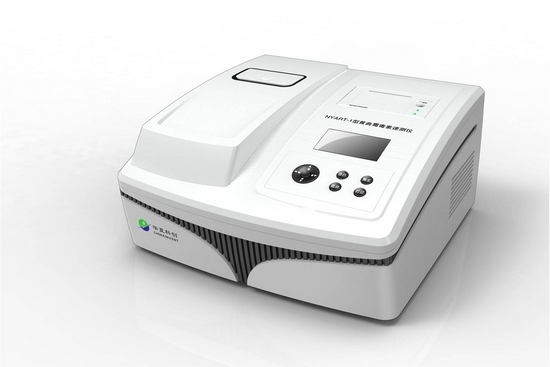分享到
Breakthrough in Ultra-High Sensitive Aflatoxin Detection Technology
The ultra-high sensitive analytical technologies for Aflatoxin, developed by the research team lead by Dr. LI Pei-wu from Oil Crops Research Institute (OCRI) of CAAS has been validated by Hubei Provincial Science & Technology Department on October 29, 2012 and was marked the international advanced level.
Aflatoxin is the strongest toxic and carcinogenic mycotoxins discovered so far. The toxicity of aflatoxin B1, for example, is ten times of potassium cyanide, 68 times of arsenic; the carcinogenicity is 75 times of standard carcinogen dimethylnitrosamine. China is geographically located in the area prone to aflatoxin contamination. Agro-products and foods contaminated by this virus are extremely detrimental to health. It is the one of the major causes for high hepatocellular carcinoma occurrence in some regions. So it is urgent and important to develop high sensitive and accurate quantitative detection technology and instruments.
OCRI researchers successfully bred a series of monoclonal hybridoma cell lines with self-intellectual property rights and developed the monoclonal antibodies with high affinity such as 1C11, 2C9, 3G1, etc. These antibodies are reported to be the most sensitive to general aflatoxins and such specific to aflatoxin B1 or M1, both in China and abroad. They also developed a series of high sensitive and analytical specific strips, kits, surrogates of aflatoxin standards materials and micro-immunoaffinity columns for general aflatoxins, aflatoxin B1 or M1, as well as three kinds of analytical instruments, including aflatoxin-immunoaffinity fluorescent fast tester, aflatoxin-single spectrum image fast tester, aflatoxin-lateral flow immune time -resolved fluorescent instrument. These techniques and tools enable the high-sensitive, accurate and quantitative detection for aflatoxins and have been applied to 65 kinds of agricultural products (peanuts, corn, rice etc.), edible oil(peanut oil, corn oil etc.), spices (peanut butter, soy sauce, vinegar etc.), dairy products (fresh milk, milk powder etc.) and feeds. The test for single sample milk, for instance can be finished within 9 minutes from sampling to printing results by application of the techniques and testers.

The study started in 1999, was supported by China national scientific and technological key project, Hubei Provincial scientific and technological key project, the National Hi-Tech R&D Program and Natural Science Foundation of China in straight years. The group applied 20 domestic and international invention patents including authorized 10 items, and published more than 40 research papers including 18 SCI ones.
Aflatoxin is the strongest toxic and carcinogenic mycotoxins discovered so far. The toxicity of aflatoxin B1, for example, is ten times of potassium cyanide, 68 times of arsenic; the carcinogenicity is 75 times of standard carcinogen dimethylnitrosamine. China is geographically located in the area prone to aflatoxin contamination. Agro-products and foods contaminated by this virus are extremely detrimental to health. It is the one of the major causes for high hepatocellular carcinoma occurrence in some regions. So it is urgent and important to develop high sensitive and accurate quantitative detection technology and instruments.
OCRI researchers successfully bred a series of monoclonal hybridoma cell lines with self-intellectual property rights and developed the monoclonal antibodies with high affinity such as 1C11, 2C9, 3G1, etc. These antibodies are reported to be the most sensitive to general aflatoxins and such specific to aflatoxin B1 or M1, both in China and abroad. They also developed a series of high sensitive and analytical specific strips, kits, surrogates of aflatoxin standards materials and micro-immunoaffinity columns for general aflatoxins, aflatoxin B1 or M1, as well as three kinds of analytical instruments, including aflatoxin-immunoaffinity fluorescent fast tester, aflatoxin-single spectrum image fast tester, aflatoxin-lateral flow immune time -resolved fluorescent instrument. These techniques and tools enable the high-sensitive, accurate and quantitative detection for aflatoxins and have been applied to 65 kinds of agricultural products (peanuts, corn, rice etc.), edible oil(peanut oil, corn oil etc.), spices (peanut butter, soy sauce, vinegar etc.), dairy products (fresh milk, milk powder etc.) and feeds. The test for single sample milk, for instance can be finished within 9 minutes from sampling to printing results by application of the techniques and testers.

Aflatoxin Fluoresent Fast Tester NYART-Ⅱ
The study started in 1999, was supported by China national scientific and technological key project, Hubei Provincial scientific and technological key project, the National Hi-Tech R&D Program and Natural Science Foundation of China in straight years. The group applied 20 domestic and international invention patents including authorized 10 items, and published more than 40 research papers including 18 SCI ones.
Latest News
-
 Apr 18, 2024Opening Ceremony of the Training Workshop on Wheat Head Scab Resistance Breeding and Pest Control in Africa Held in CAAS
Apr 18, 2024Opening Ceremony of the Training Workshop on Wheat Head Scab Resistance Breeding and Pest Control in Africa Held in CAAS -
 Apr 03, 2024IPPCAAS Co-organized the Training Workshop on Management and Application of Biopesticides in Nepal
Apr 03, 2024IPPCAAS Co-organized the Training Workshop on Management and Application of Biopesticides in Nepal -
 Mar 28, 2024Delegation from the School of Agriculture and Food Science of University College Dublin, Ireland Visit to IAS, CAAS
Mar 28, 2024Delegation from the School of Agriculture and Food Science of University College Dublin, Ireland Visit to IAS, CAAS -
 Mar 25, 2024Director of World Food Prize Foundation visited GSCAAS
Mar 25, 2024Director of World Food Prize Foundation visited GSCAAS -
 Mar 20, 2024Institute of Crop Sciences (ICS) and Syngenta Group Global Seeds Advance Collaborative Research in the Seed Industry
Mar 20, 2024Institute of Crop Sciences (ICS) and Syngenta Group Global Seeds Advance Collaborative Research in the Seed Industry
